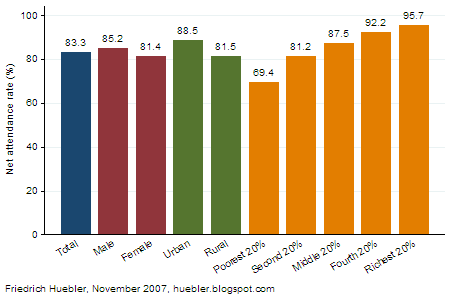According to data from a nationally representative Demographic and Health Survey (DHS), the primary school net attendance rate (NAR) in India was 83 percent in 2006. (In India, the DHS is referred to as National Family Health Survey or NFHS.) In other words, more than 8 out of 10 children of primary school age (6-10 years in India) were attending primary school. In 2000, the primary school net attendance rate was 76 percent. Although the attendance rate has increased, there are persistent disparities in the education system of India. The bar graph below displays the primary school NAR by sex, area of residence, and household wealth. 85 percent of all boys and 81 percent of all girls are in school and the country is therefore close to gender parity. On the other hand, there is a larger gap between urban and rural areas. The urban primary NAR is 89 percent and the rural NAR is 82 percent.
Primary school net attendance rate (NAR), India 2006

Data source: India Demographic and Health Survey 2005-06
Disaggregation by household wealth reveals even greater disparities. 96 percent of all primary-school-age children from the richest household quintile are in school. With declining household wealth, the share of children in school also falls. In the poorest household quintile, the primary NAR is only 69 percent, almost one third below the NAR in the richest households. As a consequence, children from the poorest households make up almost half of all children out of school in India. An earlier article on this site contains additional data on children out of school in India.
Note on NAR calculation
The official report for the India DHS lists the primary NAR as 71.9 percent (IIPS and Macro International 2007a, Table 2.8, page 31). The primary NAR cited above, 83.3 percent, is higher because of a different calculation method. The DHS report uses the traditional definition of the primary school net attendance rate, which only considers attendance in primary school and ignores attendance at higher levels of education.
- Primary NAR (traditional definition) = Number of children of primary school age in primary school / Total number of children of primary school age
- Primary NAR (revised definition) = Number of children of primary school age in primary school or higher / Total number of children of primary school age
References
- International Institute for Population Sciences (IIPS), and Macro International. 2007a. National Family Health Survey (NFHS-3) 2005-06, India: Volume 1. Mumbai: IIPS. (Download in PDF format, 7.9 MB)
- International Institute for Population Sciences (IIPS), and Macro International. 2007b. National Family Health Survey (NFHS-3) 2005-06, India: Volume II. Mumbai: IIPS. (Download in PDF format, 4.1 MB)
- UNESCO Institute for Statistics (UIS). 2005. Children out of school: Measuring exclusion from primary education. Montreal: UIS. (Download in PDF format, 4.9 MB)
- Primary school attendance by state in India
- India has 21 million children out of school
- Educational attainment in India, 1950-2000
- Primary school completion in India, 1950-2000
- Education disparity in South Asia
- 115 million children out of school
- Demographic and Health Survey (DHS), India
- National Family Health Survey (NFHS), India
- UN Millennium Development Goals
Permanent URL: http://huebler.blogspot.com/2007/11/primary-school-attendance-in-india-in.html
No comments:
Post a Comment